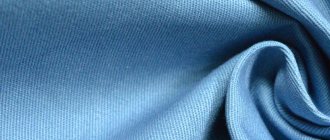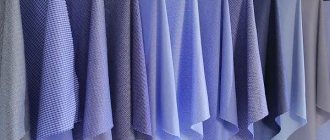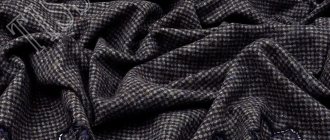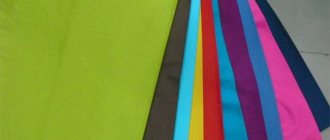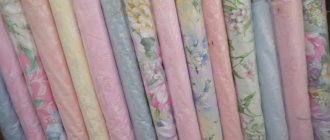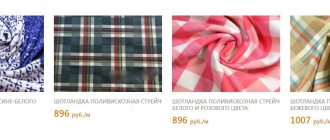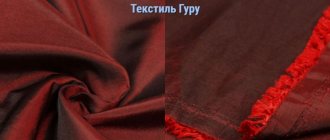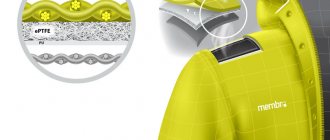What type of fabric is this
Cashmere is a warm, delicate, soft, airy material. Typically used to produce high-end clothing. The composition of the product is high quality animal down. Once a year (May, June) it is collected during the molting of goats. Special scallops are used. The diameter of the villi is 6 times thinner than human hair.
The resulting raw materials are sent for cleaning and degreasing.
One animal produces about 180 g of primary material. After processing, less than 100 g remains. Losses are about 50%.
Cashmere shades
The next step is to sort the thread by thickness and spin it. The work is done manually. The fibers are then dyed.
There are two types of yarn: pashmina (delicate fluff, cross-section no more than 15 microns), semi-pashmina (cashmere) fiber thickness is about 19 microns. After all the above procedures, the threads are sent to weaving factories. Fabrics are made in two ways - twill weave or knitted (knitting).
Check the fibers
Slowly and confidently move your hand from top to bottom. If any fibers fall out and clump together in your hand, the cashmere was most likely made from short cashmere fibers. High quality cashmere knitwear is made from long, thin cashmere fibers. All cashmere loses fibers over time, but if they fall off a new item, the cashmere is likely to be of poor quality.
Are cashmere socks worth the money?
On plump legs, stockings look defiantly erotic.
Stockings on thin legs immediately make you want to read poetry. — Irina Pribora
Socks tags
Origin story
It is unknown who first came up with this method of obtaining excellent material. The name cashmere comes from the province of Kashmir, which is located in India. The fabric was first heard of in the 12th century. The book of the Persian kingdom depicted shawls made of amazing fiber.
Napoleon brought the material to Europe. From the countries of the East he brought a gift to his wife - a transparent shawl with elaborate embroidery. Josephine was delighted. After this, supplies of the product to Europe became constant.
In the nineteenth century, industrialists in this region began to try to create fabric themselves. Only the Scots succeeded. They did not raise sheep in their homeland, but began to import raw materials from China.
Application of material
Cashmere is one of the universal materials for sewing clothes. It can be used for sewing textiles for newborns, as well as for adults and teenagers.
Dresses, sweaters, and coats made of cashmere are especially valuable; not a single show is complete without them. The cost of clothing depends on the color and thickness of the raw materials.
Tips for choosing cashmere items
When choosing cashmere items, consider the following:
- Price. Real cashmere is expensive, so if you see a price tag that is too low, it is most likely a fake;
- The fabric should be elastic and dense enough to quickly return to its normal state. When stretched, cashmere should be uniform in color;
- The label of a quality item must indicate the number of threads from which it is made. For thin, light items there should be at least 2 threads, and for denser items - 3-6;
- Only 3 countries produce natural cashmere. Italian cashmere is considered the most expensive, followed by Scottish and Chinese cashmere, respectively.
Fabric composition and its properties
Traditional high quality natural cashmere is 100% wool obtained from mountain goats. You will not find any other components in its composition - neither natural, nor artificial, nor synthetic.
Often, to reduce the cost of goods, manufacturers add to the composition: Angora rabbit fluff, the undercoat of other goats, or a synthetic analogue. All these “additives” change the original characteristics of the material.
Cashmere is the finest wool material in the world. Thin down threads give the product lightness and softness. The material is considered hypoallergenic. It retains heat well, but clothes made from it are not hot (goat hair is an excellent thermostat).
The fabric is elastic, strong and durable. The appearance of pellets on it is almost impossible. It does not wrinkle or stretch. The healing effect is another property of high quality cashmere. It will help get rid of muscle spasms and joint pain.
Care: with respect worthy of kings
One of the most delicate fabrics in existence requires careful care. She responds to some “rest”: in the evenings, taking off her cashmere clothes, let her hang on soft hangers in the air. At the same time, all microfolds are straightened out and the product takes on a fresh look.
Cashmere cannot be worn. It is recommended to wash items after every fourth wear. At the same time, carefully study the instructions from the manufacturer on the sew-in tag, because some items can only be dry cleaned.
- The items are machine washed with cool water on a delicate cycle.
- When washing by hand, you cannot rub things and change the temperature when rinsing.
- When it comes to detergents, give preference to liquid and neutral ones. Cashmere products can be washed well with baby shampoo.
- The washed items are not twisted, but lightly wrung out on a terry towel. Dry horizontally on gauze.
- If necessary, items should be ironed exclusively with steam, without touching the fabric.
- Cashmere products are stored in wooden furniture. The best wood is cedar. The phytoncides secreted by this plant repel the ubiquitous moths.
Don't forget that unwashed clothes are food for moths.
- Clean products for storage are folded so that there are no creases in the central part. Dresses and coats are stored on special soft or inflatable hangers.
Incredibly airy, soft, warm and exquisitely beautiful, cashmere has long won the leading catwalks of the planet and the recognition of lovers of elegant clothing. Products made from the “delicate gold of the East” never go out of fashion. They are always in trend and invariably are a sign of refined taste and decent income.
© 2021 textiletrend.ru
Types of fabric
Nowadays, manufacturers offer several options for the “performance” of the material. It all depends on the method of production of the thread:
- Mongolian. The raw material is the down of Chinese and Mongolian goats. The threads are processed by hand. The resulting fabric is high quality, soft and without pilling.
- Coat. Composition: cashmere goat wool (30%), wool from other animals (70%). The most famous and sought after type of cashmere. It has a homogeneous structure. It doesn't wrinkle or roll down. For expensive products, double-sided fabric is used (no lining required).
- Eco-cashmere. Considered inexpensive. Composition: polyester and viscose in a ratio of 80/20%. There is no animal undercoat in it. Therefore, such a property as thermal conductivity is less pronounced.
Cashmere luxury or what is real cashmere?
Dear friends!
Very often we hear about cashmere and about various cashmere clothes that are sold at different prices.
But few people know what real cashmere is and how to distinguish a good quality item from a fake. This article will help you figure it out.
No other fabric can be as soft, delicate, light and warm at the same time as cashmere - a unique, natural fiber. Many people make the mistake of thinking that cashmere is expensive wool or well-made wool. No, cashmere is the fluff (undercoat) of a mountain goat, plucked or combed by hand in the spring, when after the winter cold the goat no longer needs the fluff. The main suppliers of cashmere down are China (province of China called Inner Mongolia) and Mongolia. Cashmere from India (the main region is the state of Kashmir), Iran and Afghanistan also appears on the market. But this fluff is dirtier, the hair itself is thicker and darker, so the cost of such fluff is noticeably lower. Breeders tried to breed cashmere goats in other places, exporting them to Australia, New Zealand and Scotland. But in other climatic conditions, “the absence of a sharply continental climate - cold winters and hot summers,” the precious undercoat lost its qualities: lightness and amazing ability to retain heat. Europe learned about cashmere in the 18th century, thanks to Josephine. After one eastern military campaign, Napoleon brought her a woolen shawl, thin, almost transparent, decorated with embroidery, with the amazing name “Pashmina”. 200 years later, the Pashmina remains a classic accessory and essential addition to a fashionable wardrobe. Some interesting information: to obtain fluff, a goat is not shorn, but combed with a special pluck, and per year one goat brings only 100, maximum 200 grams. To knit 1 cashmere sweater you will need 4-6 animals. A voluminous cardigan with 10 threads requires 20 animals. This is one of the circumstances that determines the very high price of items made from real cashmere. How can you tell the difference between wool and cashmere? Our fingers can help us with this by detecting differences of one micron. For example, human hair is about 50 microns, and good cashmere raw material consists of threads of 16 microns. This is why touching cashmere feels so wonderful to us.
Cashmere is the soft undercoat of a goat under the main coarse hair, with which it is protected from the harsh high-altitude climate. The word cashmere comes from the name of the Kashmir province between Iran and Pakistan, where these goats were originally raised. (kashmiri goats of Himalayas). Currently, the majority of goats for cashmere production are raised in China (60-65%), Mongolia (20-25%) and Afghanistan (15%). The geographical conditions of Central Asia are ideal for raising cashmere goats. The best cashmere is grown in Inner Mongolia (autonomous region of China). Every spring, during the spring molting, this undercoat is carefully combed out. To make a scarf, you need the undercoat of one goat, and for a jacket, two or three. The quality of wool is determined by the length, texture, diameter and color of the fiber. The harsher the climate, the better the undercoat, and the more of it. Undercoats come in different colors, but white is considered the best. The most common method of collecting undercoat is still the method invented in 1870 by Scotsman Robert Dawson, whose company still exists. Cashmere was called the fiber of kings, because in addition to its softness, it is also distinguished by its warmth: experts agree that cashmere is 8 times warmer than sheep's wool!
Although cashmere fiber is mined in Asia, it is then transported to different countries for the subsequent production of clothes. Until the 80s of the 20th century, the two main producers of cashmere items were Italy and Scotland. Then China and Mongolia, in cooperation with Japanese companies, launched production at home. Their products were of poorer quality, but cheaper. This led to a more widespread distribution of the once unique cashmere, and also to the fact that Scotland and Italy began to lack quality raw materials for production, as they purchased it from China. Accordingly, because of this, as well as because of the liberalization of Chinese trade in the mid-80s, prices for cashmere down increased. The Scots found a way out of this situation by creating joint ventures with Chinese partners. Cashmere items from different manufacturers are distinguished by their softness and delicacy. This is also due to the fact that, in pursuit of cheaper production, factories choose short and thick fiber, which negatively affects the softness and durability of the product. Since Scotland mainly uses long, light and thin fiber, their sweaters are more durable and do not roll up like others, for example, Chinese ones. Scotland is considered the best country for cashmere production because it has maintained production traditions dating back to the 18th century, and every stage is checked by hand. Most of the factories have remained small family productions, which is what they are proud of. Scottish cashmere is distinguished by the fact that it is very soft and gentle to the touch, so in its production they use the so-called worsted yarn - a fiber processed by a comb. This removes all roughness and short fibers. The threads are woven lengthwise rather than across, which avoids curling into lint and spools. It is also believed that Scotland has good soft water, which during production opens the fiber and makes it softer.
It would seem that what could be more banal than cashmere? These days, prices for cashmere knitwear have dropped so low that they are literally sold everywhere. But price reductions do not happen “for free” - the secret is that the production of cashmere sweaters, scarves and other things was put on stream, while at the same time cutting corners wherever possible. This applies to the quality of raw materials, yarn processing methods, and everything else. As a result, the value of such cashmere is fully consistent with the low price at which it is sold. In my opinion, the same money could be spent much more usefully on buying good sweaters made from ordinary sheep wool! But let’s leave “supermarket” cashmere alone. There is also a very expensive Italian one. Everything is much better here (at least as regards the quality of raw materials and production methods). But! – we are again stepping on the “favorite rake” of the Italians. The main thing they strive for is to produce the thinnest and softest knitwear possible. Even softer, even thinner! As thin and soft as possible! And a little more than that! The reason is clear - when choosing a sweater in a store, an inexperienced client is guided mainly by only these two qualities - softness and thinness - especially if he has previously been thoroughly “brainwashed” by advertising. So this strategy will pay dividends. Alas! – the downside is extreme fragility.
But there is another cashmere - Scottish. Dense, so the appearance is not much different from good merino wool. And at the same time soft... although in terms of softness, of course, it is significantly inferior to the “Italians”. Durable - on English-language forums they write that a Scottish cashmere sweater can be left as an inheritance to your children (the idea is simply incredible for those who are accustomed to the fragility of “ordinary” cashmere). Not cheap at all! – but in this case the price is probably justified.
The easiest way to distinguish such cashmere from regular cashmere is to use your thumb and forefinger: pinch the fabric between them and rub the pads of your fingers against each other. What do you feel? Just your own fingers? Pass by. Or is it the fabric between the fingers? Yes, this is the same Scottish cashmere!
I invite you to visit my store, where you can purchase products made from real Scottish cashmere!
Thank you for your attention!
Pros and cons of cashmere
Advantages:
- lightness and weightlessness;
- hypoallergenic;
- strength and durability;
- low thermal conductivity (under any conditions, clothes made of this material will be comfortable;
- pellets appear occasionally (in the area of contact between the canvas and the canvas);
- natural wax contained in the thread cares for the skin;
- has a healing effect.
Flaws:
- difficult fabric care;
- high price.
Touch the thing
Cashmere is the softest and most luxurious fabric. Your fingertips should convey a pleasant sensation and pleasure when you run your hands over the fine cashmere. However, if it feels too soft or fluffy to the touch, the manufacturer may have treated it with chemicals or over-washed it to give it an artificial softness. These processes damage the fibers and reduce the strength and lifespan of cashmere. Remember that cashmere only gets softer over time as you wear it; new cashmere should be soft but firm enough to indicate that it has not been treated.

